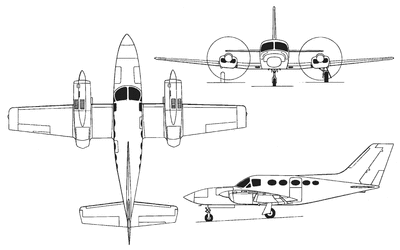Witnesses Saw Smoke And Flames On The Airplane's Left
Engine
The NTSB has released a preliminary report on a accident which
occurred December 9th involving a Cessna 421 departing from Joe
Foss Field Airport (KFSD), in Sioux Falls, South Dakota. The report
indicates that witnesses on the ground saw smoke trailing from the
left engine of the airplane on takeoff, as well as flames on the
inboard portion of the engine. All four of the people on board the
airplane were fatally injured when it went down attempting to
return to the airport.

NTSB Identification: CEN12FA100
Nonscheduled 14 CFR Part 135: Air Taxi & Commuter
Accident occurred Friday, December 09, 2011 in Sioux Falls,
SD
Aircraft: CESSNA 421C, registration: N421SY
Injuries: 4 Fatal.
This is preliminary information, subject to change, and may
contain errors. Any errors in this report will be corrected when
the final report has been completed.
On December 9, 2011, at 1424 CST, a Cessna 421C, N421SY, was
substantially damaged when it impacted terrain after takeoff from
Joe Foss Field Airport (FSD), Sioux Falls, South Dakota. The pilot
and three passengers were fatally injured. The aircraft was
registered to S & S Aviation LLC and operated by Quest
Aviation, Inc. under the provisions of 14 Code of Federal
Regulations Part 135 as an on-demand air taxi flight. Visual
meteorological conditions prevailed for the flight, which operated
on an instrument flight rules flight plan. The flight was
originating at the time of the accident. The intended destination
was Rapid City Regional Airport (RAP), Rapid City, South
Dakota.
At 1422, the FSD Air Traffic Control Tower (ATCT) issued a
takeoff clearance to the accident flight. About 30 seconds later,
the controller informed the pilot that a smoke plume was visible
behind the airplane; however, the controller could not determine
exactly from where on the airplane the smoke was coming. The
controller subsequently advised the pilot that it looked like the
smoke had stopped. At 1424, the controller cleared the flight to
land. No communications were received from the pilot after he
acknowledged the takeoff clearance.
Witnesses reported that the airplane appeared to be trailing
white smoke from the area of the left engine during takeoff from
runway 33. They subsequently observed flames at the inboard side of
the left engine. The airplane began a left turn, apparently in an
attempt to return to the airport. As the airplane continued the
turn, the flames and trail of white smoke were no longer visible.
When the airplane reached a south heading, the nose dropped
abruptly and it impacted the ground from an altitude of 800 to
1,000 feet above ground level. They stated that they heard the
engine sound increase prior to impact. A postimpact fire
ensued.
The airplane impacted an open field about 3/4 mile northwest of
the airport. It came to rest upright, with the empennage separated
from the aft fuselage. The empennage was in relative position
adjacent to the aft fuselage. The fuselage and empennage were
oriented on approximate magnetic headings of 078 degrees 151
degrees, respectively. A scorched area about 230 feet long by 40
feet wide emanated from the fuselage oriented approximately 120
degrees.
All major airframe components were located at the accident site.
The fuselage and wings were damaged by the postimpact fire. Both
the left and right engines remained attached to the airframe. The
right propeller hub was fractured and all three propeller blades
had separated. One blade was embedded into the ground adjacent to
the right horizontal stabilizer. The remaining two blades were
located in the debris field about 140 feet and 300 feet from the
right engine, respectively. The left propeller hub was also
fractured. One propeller blade had separated from the hub and was
located under the left engine. The other two blades remained
attached to the propeller hub. Teardown examinations of both
engines are pending.

The pilot held a commercial pilot certificate, with single and
multi-engine land airplane, and instrument airplane ratings. He
also held a flight instructor certificate with single and
multi-engine airplane, and instrument airplane ratings. He was
issued a first class airman medical certificate on August 15, 2011,
with a restriction for corrective lenses. At the time of that exam,
the pilot reported 3,800 hours total flight time, with 300 hours
during the preceding 6 months. The pilot's most recent regulatory
checkride was completed on November 10, 2011.
The accident airplane was a Cessna 421C, serial number 421C0051.
It was powered by two Continental Motors 375-horsepower GTSIO-520-L
turbocharged, reciprocating engines. According to maintenance
records, an annual inspection was completed on December 5, 2011, at
4,882.1 hours total airframe time. The left engine, serial number
239805-R, was overhauled and installed on the airframe in April
2004. At the time of the inspection, it had accumulated 1,499.9
hours since overhaul. The right engine, serial number 272006-R, was
overhauled and installed on the airframe in October 2011. At the
time of the annual inspection, it had accumulated 24.7 hours since
overhaul.
Weather conditions at FSD, recorded at 1356, included clear
skies with 10 miles visibility, and wind from 300 degrees at 11
knots. At 1456, the conditions included clear skies with 10 miles
visibility, and wind from 290 degrees at 10 knots.
 ANN's Daily Aero-Linx (04.16.24)
ANN's Daily Aero-Linx (04.16.24) Aero-News: Quote of the Day (04.16.24)
Aero-News: Quote of the Day (04.16.24) Airborne 04.10.24: SnF24!, A50 Heritage Reveal, HeliCycle!, Montaer MC-01
Airborne 04.10.24: SnF24!, A50 Heritage Reveal, HeliCycle!, Montaer MC-01 Airborne 04.12.24: SnF24!, G100UL Is Here, Holy Micro, Plane Tags
Airborne 04.12.24: SnF24!, G100UL Is Here, Holy Micro, Plane Tags Airborne-Flight Training 04.17.24: Feds Need Controllers, Spirit Delay, Redbird
Airborne-Flight Training 04.17.24: Feds Need Controllers, Spirit Delay, Redbird




